94% of businesses that use embedded finance report increased revenue—is it right for your business?
For small and midsize businesses (SMBs), offering a form of embedded finance—such as buy now, pay later financing or e-wallet integration—can increase revenue, customer engagement, and loyalty.
In fact, in a Capterra survey of 335 business leaders in the U.S., only 14% say that they don't plan to invest in embedded finance in the next year*.
This technology can impact your businesses in a variety of ways and it’s an opportunity most organizations don’t want to pass on, but navigating the complexity of the topic can be daunting. It can be difficult to decide when to implement this software and for which reasons, as it comes in many forms.
Whether your business is already harnessing embedded finance or you’re looking to launch this service for the first time, these five trends from our survey can help you refine your strategy and enter 2023 equipped with everything you need to know about this tech.
/ Key findings
94% of businesses that offer a form of embedded finance say their revenue has risen since implementation.
90% of businesses that have used embedded finance since the pandemic report increased customer loyalty, among other benefits.
87% of businesses note that they’d be more likely to use a form of embedded finance during a recession.
28% of businesses say they offer embedded payments—the leading form of embedded finance technology.
23% of businesses considering offering embedded finance solutions gravitate toward buy now, pay later lending and other consumer-oriented products.
What is embedded finance?
Embedded finance is a financial product that is placed in a nonfinancial customer experience, journey, or platform.
Embedded finance isn’t a new concept. Auto loans at a dealership, for example, have existed for decades and are emblematic of embedded lending. So why is embedded finance so hot right now? In short, the pandemic changed the way consumers want to interact with businesses—they now prefer digital experiences and offerings that are intuitive, seamless, and integrated into a business's platform.
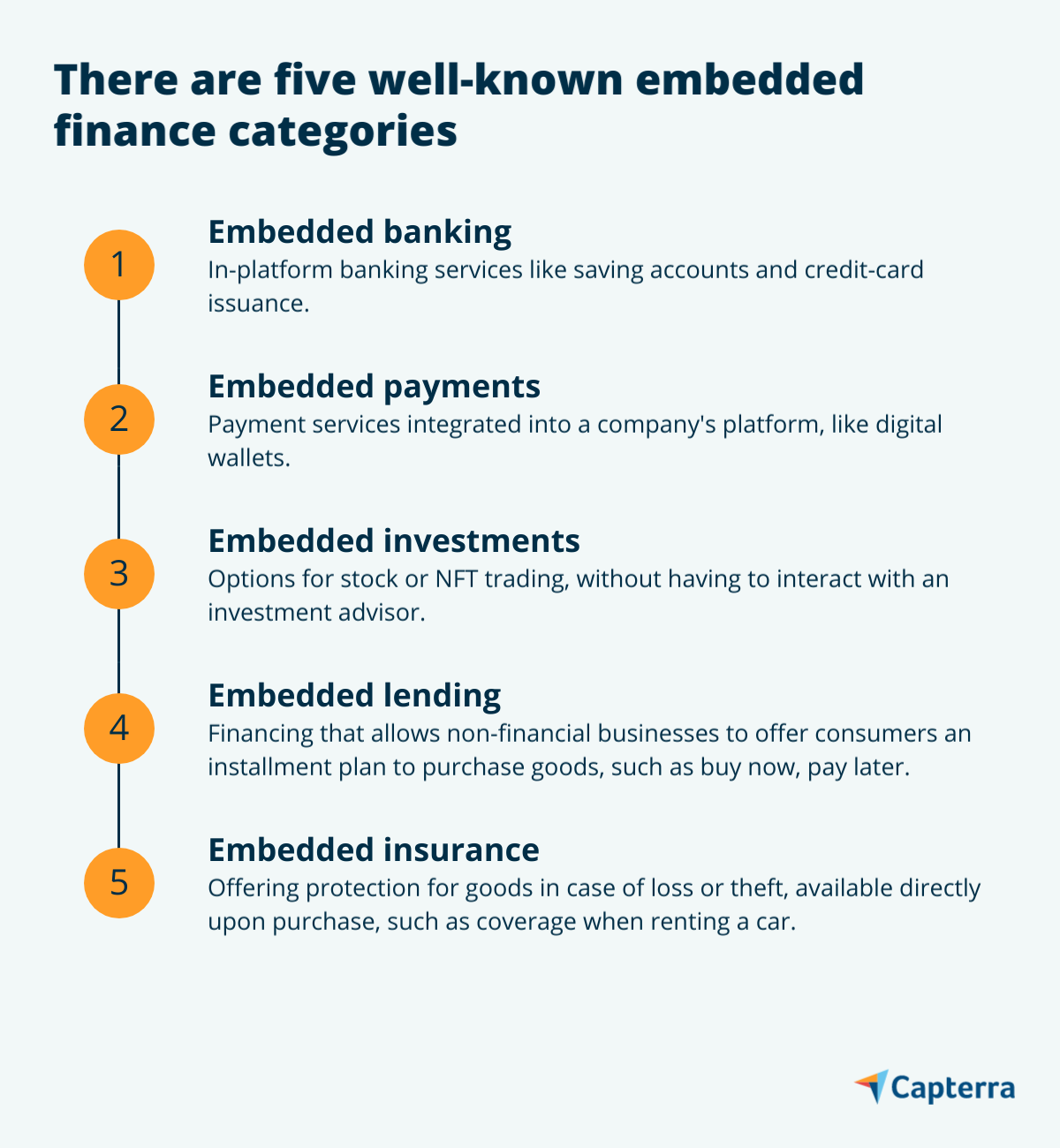
Trend #1: Businesses that offer embedded finance saw increased revenue and plan to spend more on the tech in the future
We found that 56% of respondents already offer at least one form of embedded finance. However, with five types of embedded finance solutions on the table, you might be vexed on which is right for your organization. That’s why it’s important to know which of these solutions organizations currently use the most.

Embedded payments (28%), banking (27%), and investments (19%) are the top three solutions organizations offer customers. Though each of these forms of embedded finance technology can be realized in different ways according to an organization’s needs, it’s helpful to highlight a few popular examples of these leading solutions:
Embedded payment solutions: Securely storing consumers’ cards on file for future purchases so that they don’t need to re-enter payment details is an embedded payment solution that almost all digital storefronts offer.
Embedded banking solutions: Company branded debit cards for employees, such as what Lyft offers for its drivers, are a common form of embedded banking. By spending with these cards, employees can accrue cash back, rewards, and more.
Embedded investments solutions: Typically, this tech gives consumers the ability to manage investments without leaving a platform. PayPal, for example, gives its user the ability to buy cryptocurrency straight from its app.
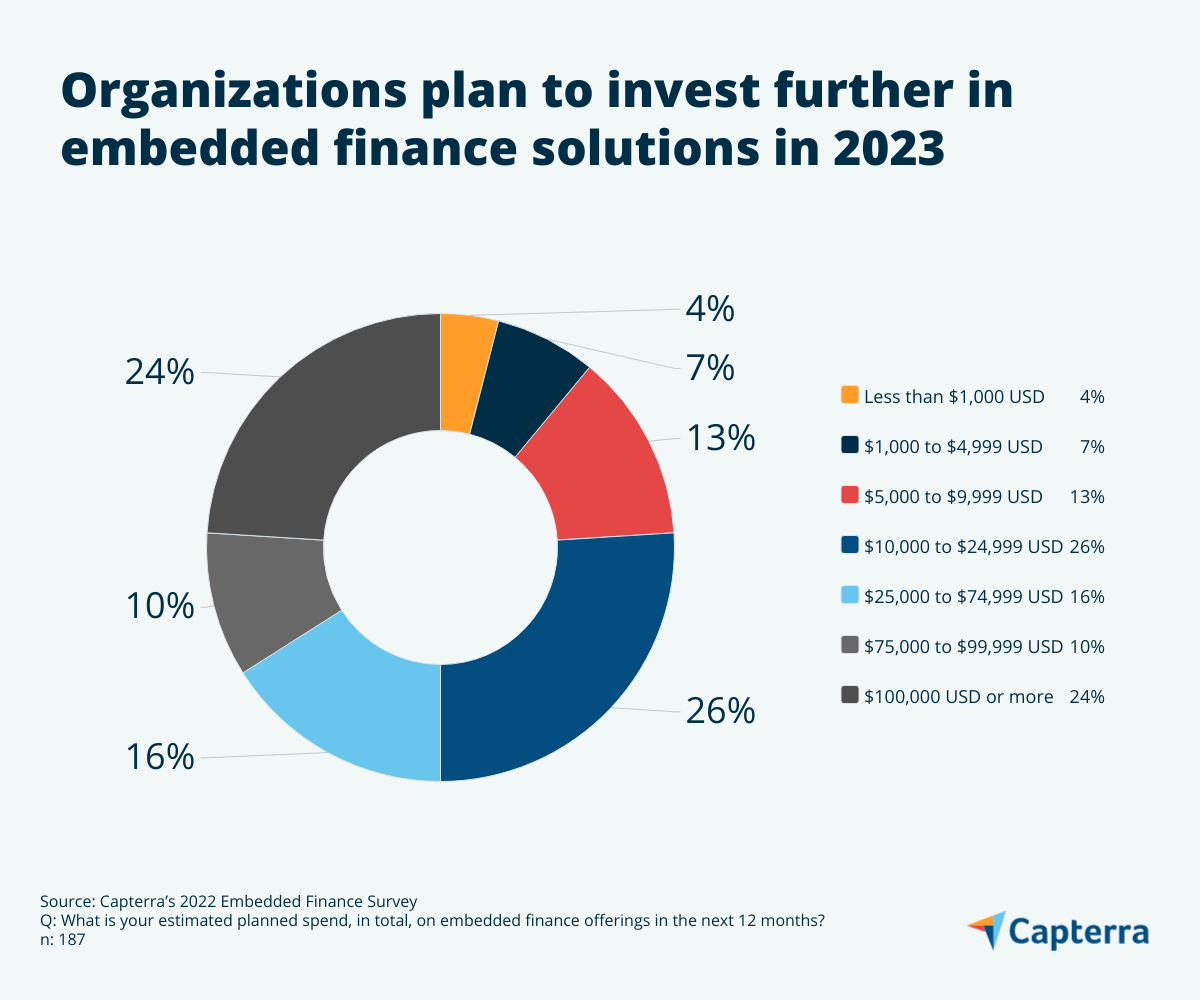
Overall, 94% of respondents say that implementing embedded finance in some way has had a positive impact on their revenue, compared to only 6% who feel it’s made no change. In light of this, businesses reveal that they’ll continue investing in these solutions in the future—75% of organizations have earmarked between $10,000 to $1,000,000 USD or more for embedded finance offerings this year.
Trend #2: The pandemic highlighted the need for embedded finance and drove adoption
The pandemic and the aftershocks of its impact have created a drastic shift in consumer preferences and behaviors. For example, business loyalty has become more fragile since COVID-19, as 61% of customers will switch to a competitor after one bad experience, according to Forbes[1].
Additionally, consumers want personalized shopping experiences, which organizations can usually only curate successfully through data gathering and analytics. Underpinning this all is the need for organizations to provide a sleek and convenient UX that meets customer demands.
This means that to stay competitive and consumer-focused, businesses need to adapt. And how did organizations do just that? By tapping into embedded finance.
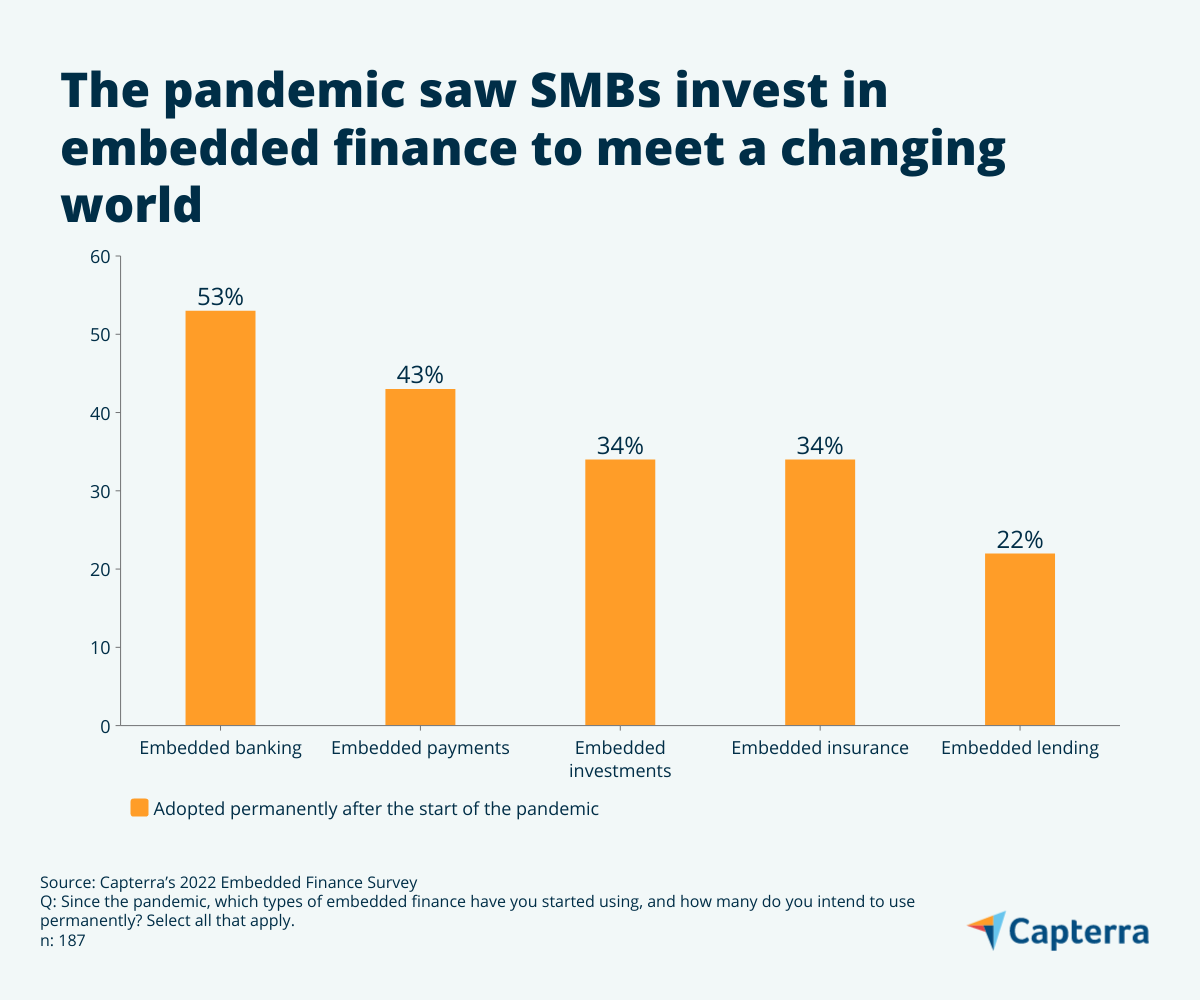
Since the start of the pandemic, embedded banking (53%), payments (43%), and investments (34%) technology are the top three solutions SMBs permanently adopted. Consumer demand was one important factor in driving businesses to harness embedded finance, as were the opportunities to use the technology to increase revenue. However, respondents say that increasing convenience (23%), building up the ability to foster customer loyalty and sign-ups (14%), and improved analytics (11%) were other notable motivators that led them to implement these solutions.
Beyond increasing revenue, our research finds that embedded finance solutions have positive impacts on business metrics and can assist organizations in addressing consumers’ post-pandemic preferences.
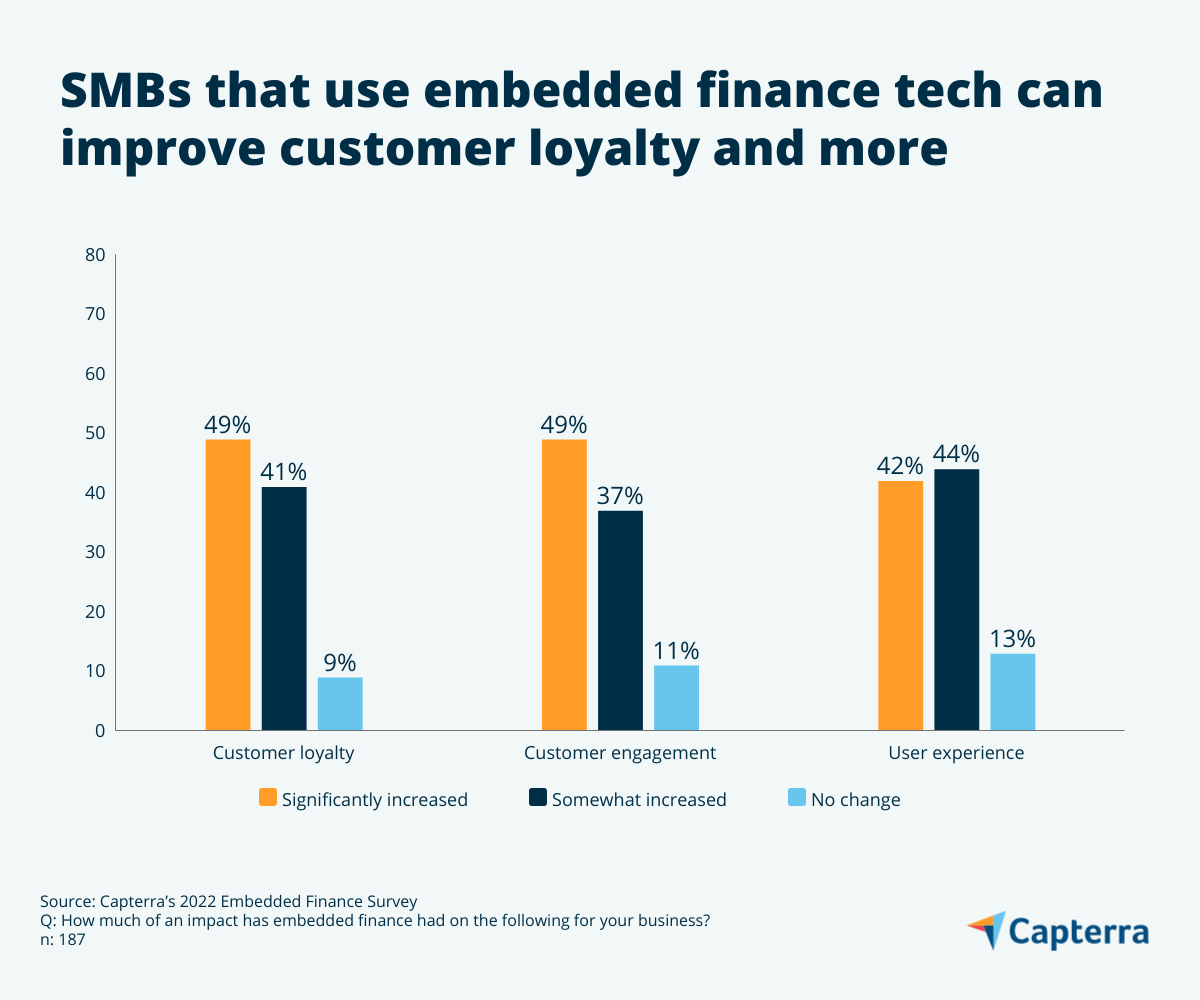
Respondents say that using a form of embedded finance increased customer loyalty (90%), customer engagement (86%), and their user experience (86%). Additionally, 80% of organizations feel their competitive advantage has grown as a result of embedded finance adoption.
Trend #3: SMBs are divided on how to offer embedded solutions but the majority have regrets related to implementation
While respondents align on the positive impacts embedded finance has had on their businesses, it also reveals SMBs are mixed on how to offer these solutions. Do they build, buy, or partner?

Almost one-third of respondents prefer to partner with a third-party provider (32%), rather than a bank (6%), to incorporate embedded finance technology. A similar number of businesses opt to buy existing software (31%), while others build embedded finance solutions themselves (28%).
However, businesses need to carefully consider all the implications that come with what format or partner they choose. If not, they might end up regretting their decision—in fact, more than half of respondents (57%) share that they have buyer’s remorse related to their embedded finance investment or implementation in the past 18 months.
Issues with cost (17%) and difficulty proving ROI (5%) arose; however, they aren’t the leading reasons SMBs feel let down by the embedded finance technology they chose. Respondents feel that lack of support (20%) associated with their embedded finance investment, an implementation process that was slow or difficult (17%), and a buggy product (15%) colored their buyer’s remorse.

For instance, our recent research into buy now, pay later (BNPL), a form of embedded lending, reveals that shoppers are more likely to spend with your business if you provide a form of this payment processing software. Since there are plenty of providers on the market, it’s likely not in your best interest to build out a costly, custom solution. You could buy this software outright but you might struggle with implementation or lack of on-going support. In this case, you might want to work with a third-party provider, as they offer brand-name recognition, easy integration, and certain qualities that entice consumers, like custom BNPL financing plans that don't carry interest.
Trend #4: Organizations across business models and industries find embedded finance especially valuable during a recession
Unfortunately, the recession outlook for 2023 will see banks slowing new lending and an environment where consumer delinquencies from everything to credit card and mortgage spaces are on the rise[2].
Even when faced with these challenges, 87% of businesses, regardless of business model or industry, say they’d be more likely to use a form of embedded finance in such a period.
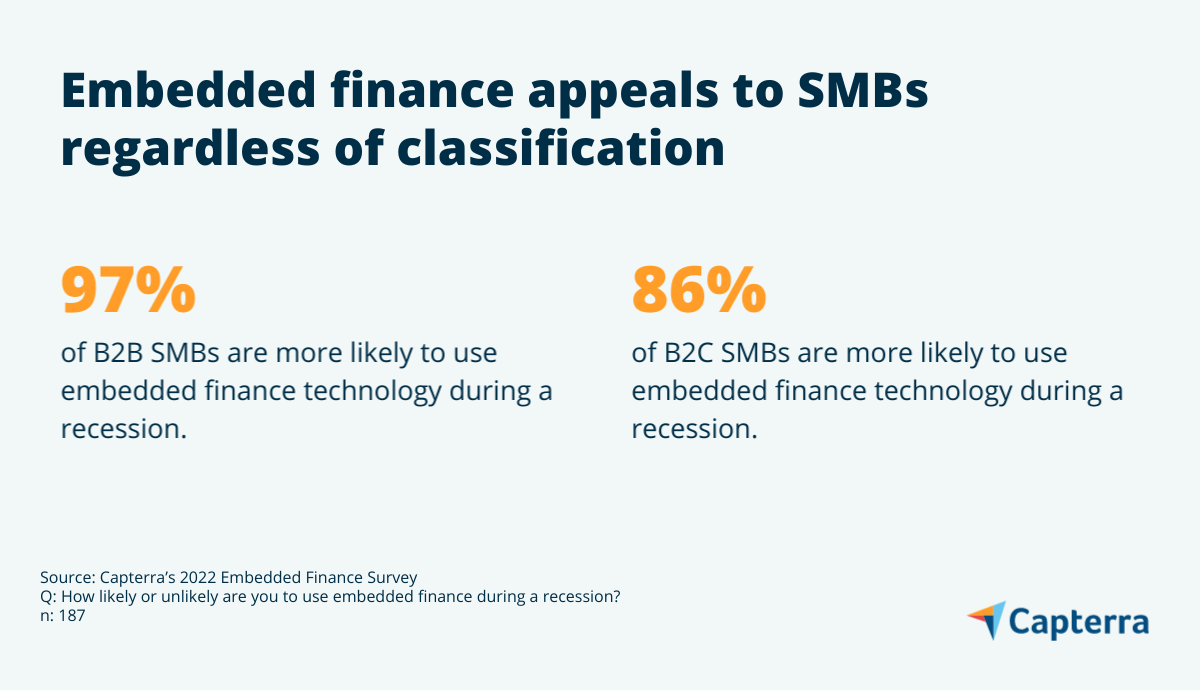
A majority of B2B respondents, B2C SMBs, and businesses that identified as a mix of both saw value in this technology given rocky economic conditions. Drilling down further based on industry, information technology and services software (37%), construction and contracting SMBs (28%), and banking and financial firms (26%) are the most likely to use embedded finance when faced with recession concerns.
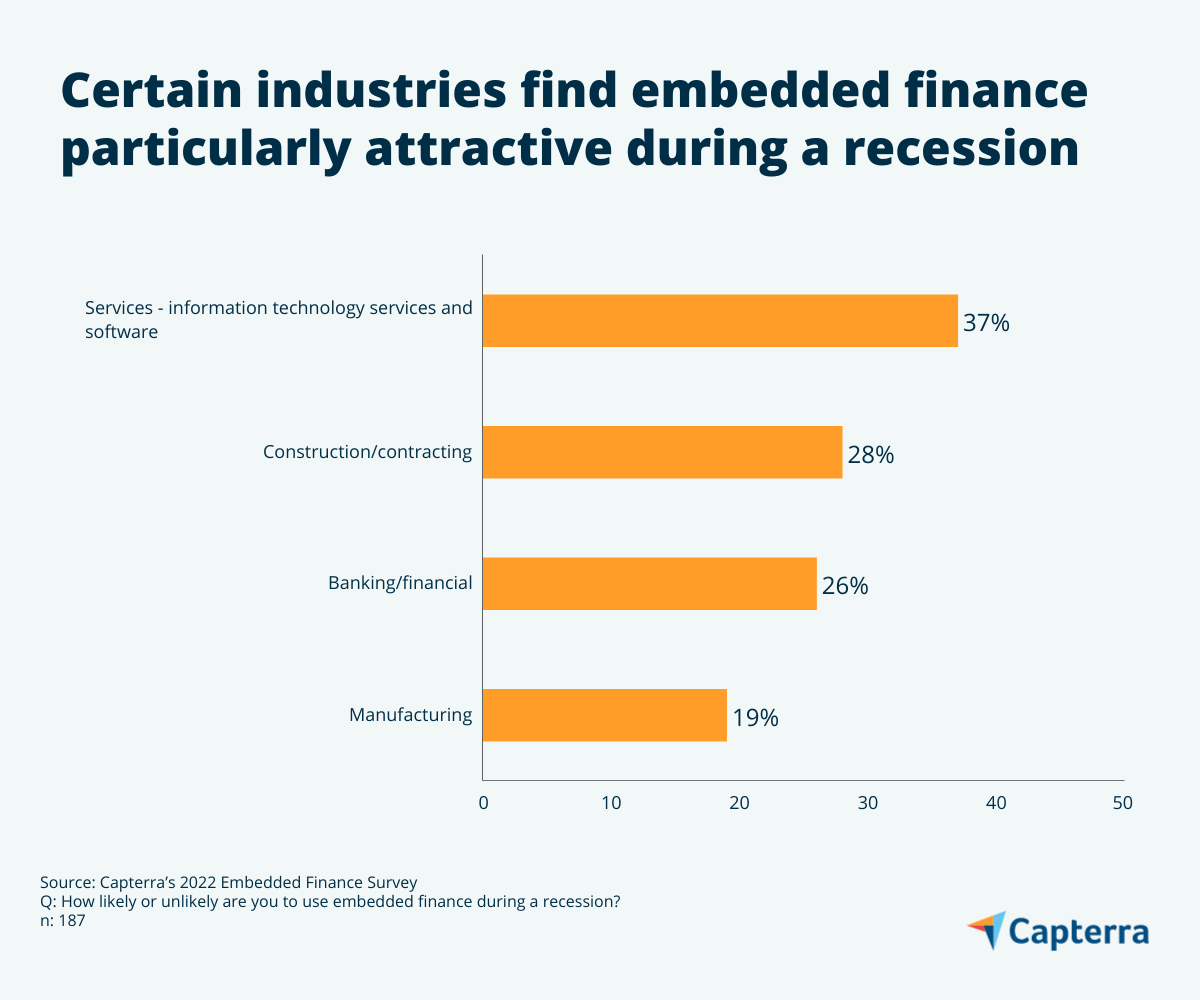
Though a majority of respondents find embedded finance an attractive option in light of an economic downturn, this data highlights that certain industries may derive more value than others when incorporating embedded finance technology into their tech stacks or business offerings. To give a clearer perspective on when it could be useful for your business, read on to see which embedded finance technology and specific use cases are most appealing to respondents.
Trend #5: Payment solutions and consumer-oriented products are the most appealing to SMBs
Businesses that haven't adopted embedded finance technology but are considering it over the next two years are interested in incorporating embedded payments (35%), banking (30%), or lending (13%) products. Thematically, they are drawn to embedded finance products that are customer-focused.
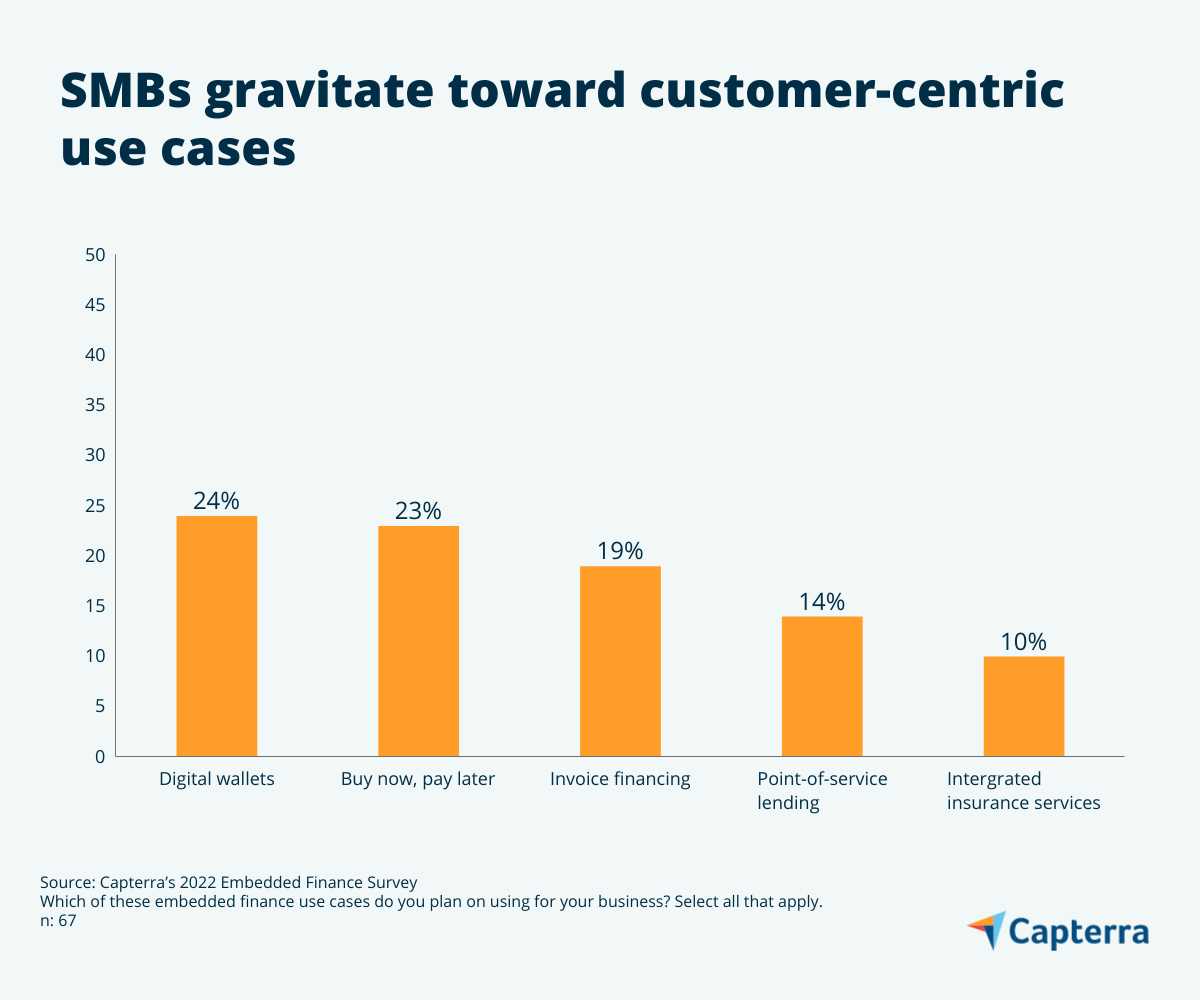
Digital wallets (24%), buy now, pay later lending (23%), and invoice financing (19%) are the top three services respondents see potential value in.
Given these findings, businesses seem to be drawn to embedded finance solutions that have been established on the market and are the most well known. These types of embedded finance technologies are already familiar to consumers and have track records of usefulness and positive ROI.
Embedded finance is booming, but still developing—let us help you determine if it’s right for your business
As the market for embedded finance continues to grow, investing in embedded finance can help you grow your business, improve a variety of customer metrics, and prepare you for an impending recession. However, navigating the hype of this expansive topic isn’t easy, and requires you to thoughtfully consider how you offer these services and for what reasons in light of these defining trends.
You can conduct research to see if your competitors are offering embedded finance in your industry, survey your customers on what solutions they’d be most likely to appreciate and use, and realign your strategy based on surfaced pain points regarding preferences toward payments, banking, etc.
Here are some high-level approaches you should keep in mind, as well:
Think big, start small: Working embedded finance into all facets of your business can seem tempting—there’s a lot you can offer—but it’s best to develop one product and move from there. For instance, you can make it easy for your customers to save their payment credentials on your site and then offer digital wallets in the future to help protect sensitive information.
Communicate with your customers: Embedded finance can be complex enough as it is, and providing your customers with a simple and comprehensive summary of what they gain from tapping into your offerings is key. For instance, you can let them know you’re now offering a buy now, pay later program and that they can garner discounts or loyalty points when spending in this new way.
Be mindful of regulations: The Consumer Financial Protection Bureau issued a statement in September that highlights newfound consumer risks associated with buy now, pay later programs[3]. This underscores that embedded finance solutions are facing increased scrutiny in the future and that businesses need to keep their consumers' best interests at heart, and their regulatory practices updated, when offering these products.
You can acclimate yourself with our report on the state of the accounting industry to see which financial software and trends will shape 2023, and explore more research on one of the most utilized forms of embedded finance—buy now, pay later lending—to help determine if this technology is right for your SMB.

